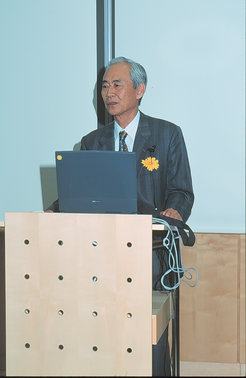Yasuo Tanaka 1931-2018
Obituary by Joachim Trümper

Yasuo Tanaka was born in 1931 near Osaka, Japan, as the middle of three sons. During World War II, he had to work as a child in a factory and experienced heavy bombardment, but also in the following years he had to endure hardship and a period of hunger. He entered the physics department of Osaka University in 1950 and received his PhD in Physics in 1961, working already as member of the extensive air shower group of Minoru Oda at the Institute for Nuclear Study (University of Tokyo).
We first met at the Cosmic Ray conference in Kyoto in 1961, after which he showed me the very impressive air shower array in Tokyo. In 1962, he accepted an offer by Satio Hayakawa to become assistant professor at Nagoya University and only one year later, he followed an invitation by Jan Oort to come to the Netherlands. It was his first contact with the western astronomical community, and later he often said that these four years changed his life. Conversations with the famous astrophysicists Jan Oort, Henk van de Hulst were illuminating for the young scientist, and the coeval Lo Woltjer and Johan Bleeker became his life-long friends. Together with Bleeker he started the Nagoya-Leiden collaboration aiming at the measurement of cosmic ray electrons with balloon borne instruments.
Also in 1962, the first extrasolar X-ray source Sco X-1 and the soft X-ray background were discovered by Riccardo Giacconi and his group, changing the life of many cosmic ray scientists, among them were Tanaka and Bleeker, who shifted the focus of their joint balloon programme from cosmic ray electrons to the hard X-ray background. This pioneering effort continued after Tanaka went back to Nagoya in 1967, where he got involved in the X-ray satellite programme initiated by his teacher Oda at the University of Tokyo.
In 1974, Tanaka moved to the Institute of Space an Aeronautical Engineering (ISAS), which had become the central institution for space research in Japan. During his 20 years at ISAS, he organized the research programme devoted to X-ray astronomy as Principal Investigator of four satellite missions: Hakucho (launched in 1979), Tenma (1983), Ginga (1987) and ASCA (1993). For two further missions, Hinotori (1981) and Yohkoh (1991), he served as advisor. This impressive X-ray programme was using Japanese rockets and spacecrafts, developed at ISAS. Its motto was “fast is beautiful”, and while it started as a purely national programme, the rapidly increasing complexity of the scientific instrumentation required substantial international participation in the later missions, both from Europe and the US.
These X-ray satellites led to a long list of important scientific results and discoveries in various fields of astrophysics. Tanaka’s own scientific interest was primarily the physics of matter accreting stellar and massive black holes. He co-authored a number of review papers on the subject and was lead author of a seminal Nature paper based on the discovery of the skew iron Ka-line in the spectrum of the active galaxy MCG-6-30-15 with Ginga, which opened a whole new field. ASCA was extremely successful as well. Together with ROSAT, which had complementary scientific capabilities, it dominated X-ray astronomy in the 1990’s. Tanaka’s great achievements at ISAS were a result of his organizational abilities and his perceptivity, long-sightedness and determination.
After his retirement from ISAS in 1994, Tanaka moved to MPE, financed with his Humboldt Price. Here he continued his scientific work together with scientists from MPE/MPA and his former colleagues in Japan. In 1995 he was appointed Director of the European/German office of the Japanese Society for the Promotion of Science (JSPS) in Bonn. He steered the work of this office largely from MPE until 2008.
For his achievements, Tanaka received a large number of honours from national and international organisations. In Germany, he was awarded the Humboldt Prize (1994), the Eugen and Ilse Seibold Prize of the German Science Foundation (1999), and the Order of Merit of the State of North Rhine-Westphalia. In 2001, he became External Scientific Member of the MPE. However, for him the last and most important recognition was his election to the most prestigious Japan Academy in 2012.
Until the very end he participated in the scientific life at MPE and MPA. Every morning he came to the institute and stayed until late hours. At our daily luncheons we enjoyed discussing both recent progress in astrophysics and general world topics. Between him and his wife Toshiko and the families of several MPE and MPA colleagues close friendships developed. The Tanakas liked the nearby mountains and lakes; they travelled all over Germany during their vacations and in Bavaria on weekends. They were delighted by the rich cultural scene in Munich and often spent New Year’s Eve in Vienna, enjoying in particular the “Fledermaus” by Johann Strauss.
In the last few years, Tanaka’s health worsened considerably and he finally decided to return to Japan. Early October 2017, they flew back to their home and their sons in Tokyo.
With him, our institute and the astrophysical community loose a great scientist and a friend with a warm and generous personality. He will be fondly remembered by his colleagues, friends and astronomers all over the world.












